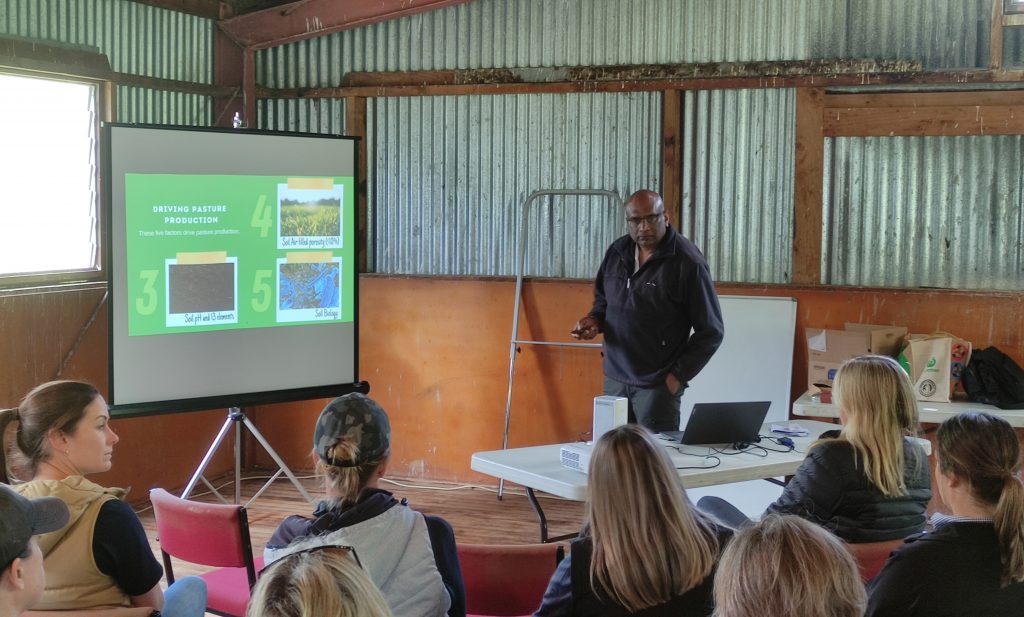The Road to Healthy Profits
Written by Sean Toohey Healthy Animals Means Healthy Profits We recently had the pleasure of participating in the Wairarapa Rural Women’s Initiative Discussion Group. The theme of the October meeting was better farm management through alternative fertiliser options. The event was held in the woolshed at our very own Jeane Fowler’s sheep and beef farm in Alfredton. A group of twenty or so farming ladies and a few farming fellas got together to hear from two industry experts on practical considerations when considering a move to alternative, environmentally friendly and financially sustainable practices to run a productive, profitable farming operation. That’s quite a mouthful but that is exactly what the session was all about. Joining us on the day were Gordon Rajendram, a Waikato-based soil scientist who helps New Zealand farmers make better fertiliser decisions, and Raymond Burr, ex-dairy farmer and owner of independent testing lab Qlabs in Waipawa. Gordon and Ray both tackle the opportunity to change from a dollars and cents perspective. A view they hold in common is that farming profitability starts with healthy soil to generate nutritious plants that provide a healthy well-balanced feed for the animals. It is more than just a consideration of cost of inputs vs outputs, there are many benefits to starting with what’s in the soil that deliver direct to the bottom-line of a farm’s profitability. Ray and Donna’s Journey Ray and Donna Burr converted their sheep and beef farm in King Country to a dairy platform back in 1990, milking 520 cows back when the average cow herd was 125 cows. They were quite innovative in what they were doing until the wheels fell off. Too much nitrogen, too much phosphate and too many health issues with the cows. After receiving little useful information from some of the top scientists in New Zealand and consulting a laboratory that could not offer independent advice, Ray sought out a niche laboratory in Hawkes Bay which was able to offer him analysis and advice across the full 13 elements. Ray says “The animal health turn around on the farm was simply amazing. After 3 years: no CIDRs, no inductions, no downer cows, a ten-week mating period, eight-week calving period and a vet visit once per year.” Increased milk solids per cow and some very healthy improvements to the bottom-line of the farm. Raymond Burr, Qlabs ”The animal health turn around on the farm was simply amazing. After 3 years: no CIDRs, no inductions, no downer cows, a ten-week mating period, eight-week calving period and a vet visit once per year. Raymond BurrOwner, Qlabs and ex-Dairy Farmer Ray, Donna and one herd manager ran the 520 dairy cows and around 250 young stock. The three of them did all their own crops, regrassing and fertiliser applications. Nitrogen use went down to 15 kilograms of urea per hectare for one third of the farm in the first rotation. As Ray says “I don’t think we needed it, but hey it was a feel good factor”. The laboratory Ray sought out in 2000 was Quantum Laboratories, the New Zealand arm of a US operation. Ray and Donna bought the business outright in 2016 and run the renamed QLabs as an independent, family-owned laboratory that is focused on animal performance starting with the soil and the plant. Today from its beginnings as Quantum Laboratories, QLabs has been in operation for 45 years. QLabs recently patented RNJE – urinary nitrogen evaluation from testing pastures which offers farmers a pragmatic measure to assess how to moderate N losses and nitrous oxide volatilisation. Show Me The Money As Ray says “It’s all about soil health, plant health and animal health. And at the end of the day, it’s the animals and their produce that fund the whole operation. Kilograms of dry matter? Anybody can grow kilograms of dry matter, just add urea. But that is not animal performance. We soil test for all 13 elements in the lab and we won’t make a fertiliser recommendation, unless we’ve tested for all of them because something small might be the limiting factor.” The Bottom Line? On their King Country dairy farm, they achieved a cash flow turnaround of approximately $250,000 per annum within 3 years – milk pay out adjusted. Ray took the group through an interactive whiteboard session to demonstrate the operational and cash flow benefits of improved animal health across a farming platform. It was very much “dollars and sense” discussion and, yes, it starts in the soil. Soil Scientist Gordon Rajendram Dr Gordon Rajendram (PhD) is a Waikato-based soil scientist. With more than 35 years’ experience in analytical testing, applied research including 22 years at AgResearch in Ruakura, Gordon now provides independent advice to farmers and fertiliser companies around New Zealand. Gordon Rajendram, Soil Scientist ”Soil testing allows farmers to make the best and most informed, data-based decisions for their farm, resulting in healthier land and stock as well as making a difference to your bottom-line Gordon RajendramSoil Scientist Gordon started by touching on the five universal factors in the soil that drive pasture growth: soil temperature above 5 or 6 degrees celcius (at 10cm depth), soil moisture above 25%, soil pH (ideal pH range 6.2-6.5) and 13 nutrients, good structure and porosity for air flow and good soil biology. These are like the soil hygiene factors for good pasture growth. Testing 1,2,3 Gordon’s non-negotiable is that soil, pasture and animal blood tests are key if farmers want to get the most out of their fertiliser applications. Soil and herbage tests will provide farmers with accurate data about the mineral imbalances that may be affecting the health of their crops or livestock. For Gordon, the devil is always in the data details. He advises “Soil testing allows farmers to make the best and most informed, data-based decisions for their farm, resulting in healthier land and stock as well as making a difference to your bottom-line”. His recommendation is to develop fertiliser programmes specific to different areas on your


